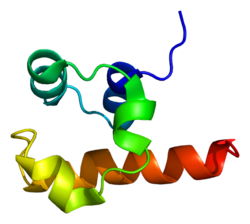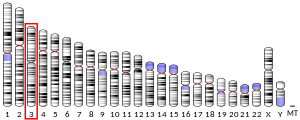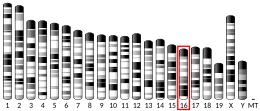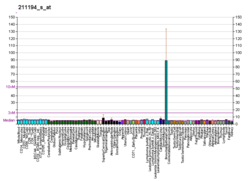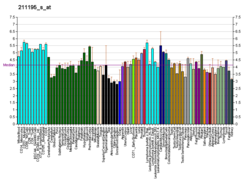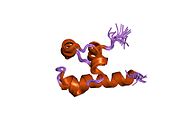TP63
TP63전형적으로 p63으로 언급되는 종양 단백질 p63은 변형 관련 단백질 63으로도 알려져 있으며, 사람에게서 TP63 [5][6][7][8]유전자에 의해 암호화되는 단백질이다.
TP63 유전자는 p53 종양억제 유전자를 발견한 지 20년 만에 발견됐으며 구조적인 [9]유사성에 따라 p73과 함께 p53 유전자군을 구성하고 있다.p53보다 훨씬 늦게 발견되었음에도 불구하고 p53, p63 및 p73의 계통발생학적 분석에 따르면 p63이 p53과 p73이 [10]진화한 패밀리의 원구성원이라는 것을 알 수 있다.
기능.
종양단백질 p63은 p53 계열의 전사인자의 일원이다.p63 -/- 마우스는 간엽과 상피 사이의 상호작용의 결과로 발달하는 사지 및 치아와 유선 등의 다른 조직의 부족을 포함한 몇 가지 발달적 결함을 가지고 있다.TP63은 대체 프로모터(TAP63 및 δNp63)에 의해 2개의 주요 Isoform을 부호화한다.δNp63은 피부발달 중 다기능과 성체줄기/[11]원조세포 조절에 관여한다.이와는 대조적으로 TAp63은 대부분 아포토시스 기능으로 제한되었고 최근에는 난모세포 [12]무결성의 수호자로서 제한되었다.최근 심장 발달과[13] 조기 [14]노화에서 두 가지 새로운 기능이 TAp63에 기인하고 있다.
마우스에서는 막단백질 PERP의 직접 전사를 통해 정상적인 피부 발달을 위해 p63이 필요하다.TP63은 또한 인간 [15]암에서 TP53과 함께 PERP 발현을 조절할 수 있다.
임상적 의의
이 유전자에서 질병을 일으키는 변이가 적어도 42개 발견되었다.[16]TP63 돌연변이는 특징으로서 [17]구순열 및/또는 입천장을 포함하는 여러 기형 증후군의 기초가 된다.그 TP63 유전자의 돌연변이가 그 영화에서 정중선 구순열은 흔한 feature,[17]lip/palate 증후군 3(EEC3)ectrodactyly-ectodermal dysplasia-cleft 증후군, 손발 가락 결손증(또한 split-hand/foot 기형 4(SHFM4 알려진)).ankyloblepharon-ectodermal dysplasia-cleftlip/palate(미국 원자력 위원회)또는 Hay–Wells 증후군이 해피 mi관련되어 있다.dli신구개열은 또한 일반적인 [17]특징이며, 아크로-더마토-웅구개열-치아증후군(ADULT), 사지-유방증후군(RHS), 랩-호지킨증후군(Rap-Hodgkin Syndrome), 그리고 구강구개열 8.
구개열을 포함하거나 포함하지 않는 구순열과 구개열만의 특징 모두 TP63 [17]돌연변이를 가진 동일한 제품군 내에서 분리되는 것으로 나타났다.최근, 유도 만능 줄기세포는 세포 재프로그래밍에 의해 EEC 신드롬에 의해 영향을 받은 환자로부터 생성되었다.결함 상피 투입은 작은 치료용 [18]화합물에 의해 부분적으로 구조될 수 있다.
분자 메커니즘
전사인자 p63은 표피 각질세포의 증식과 분화의 주요 조절제이다.최근 연구에서 연구자들은 헤테로 접합 p63 DNA 결합 도메인 돌연변이를 가진 EEC 환자 유래 피부 각질세포를 전지구 유전자 조절 변화를 특징짓는 세포 모델로 사용했다.표피 세포 정체성은 p63 돌연변이 각질세포에서 손상되었다.또한 헤테로 접합성 EEC 돌연변이를 가진 환자 각질세포에서 p63결합 손실 및 활성증강제 손실이 게놈 전체 규모로 발생한다.[19] 또한 멀티오믹스 어프로치를 사용하여 p63 및 CTCF에 의해 매개되는 DNA 루프의 규제 해제 기능은 질병 메커니즘에 대한 추가 층을 나타낸다.표피 각질세포에서 CTCF에 의해 매개되는 염색질 상호작용 내 '조절 크로마틴 허브'로 다수의 표피 주변 유전자들이 조직된 것으로 보인다.이러한 허브에는 여러 개의 접속 DNA 루프가 포함되어 있어 CTCF 바인딩은 다소 스태틱할 뿐만 아니라 문자 변환 액티비티를 위해 p63 등의 셀타입 고유의 TF 바인딩도 필요합니다.이 모델에서 p63은 DNA 루프를 전사에서 활성화하기 위해 필수적일 수 있습니다.[20]
외음부암
TP63은 IRF6 종양 억제 유전자의 과메틸화 유도 불활성화와 관련하여 벌바 편평세포암 샘플에서 과다 발현된 것이 관찰되었다.[21] 실제로 TP63의 mRNA 수치는 정상 피부 및 재생성 외음부 병변과 비교했을 때 벌바 암 샘플에서 더 높게 테스트되었으며, 따라서 IRF6 유전자와 종양 유전자 TP63 사이의 후생학적 교잡 관계를 강조했다.[21]
진단 유틸리티
p63 면역 항진은 전립선암과 양성 전립선 [22]조직을 구별하는 두경부 편평상피암에 효용성이 있다. 정상적인 전립선샘은 p63으로 얼룩지는 반면 전립선암은 그렇지 않다.[23]P63은 또한 잘 분화되지 않는 편평상피암과 소세포암 또는 선암을 구별하는 데 도움이 된다.P63은 잘 분화되지 않은 편평상피세포에서는 강하게 염색되어야 하지만, 작은 세포나 [24]선암에서는 음성으로 염색되어야 한다.
상호 작용
TP63은 HNRPAB와 [25]상호작용하는 것으로 나타났습니다.또한 IRF6 인핸서 [17]요소를 통해 IRF6 전사를 활성화합니다.
규정
p63의 발현이 단백질 수준에서 microRNA miR-203과[26][27] USP28에 의해 조절된다는 증거가 있다.
「 」를 참조해 주세요.
- AMACR - 전립선암에 대한 또 다른 마커
레퍼런스
- ^ a b c GRCh38: 앙상블 릴리즈 89: ENSG00000073282 - 앙상블, 2017년 5월
- ^ a b c GRCm38: 앙상블 릴리즈 89: ENSMUSG000022510 - 앙상블, 2017년 5월
- ^ "Human PubMed Reference:". National Center for Biotechnology Information, U.S. National Library of Medicine.
- ^ "Mouse PubMed Reference:". National Center for Biotechnology Information, U.S. National Library of Medicine.
- ^ Yang A, Kaghad M, Wang Y, Gillett E, Fleming MD, Dötsch V, et al. (September 1998). "p63, a p53 homolog at 3q27-29, encodes multiple products with transactivating, death-inducing, and dominant-negative activities". Molecular Cell. 2 (3): 305–16. doi:10.1016/S1097-2765(00)80275-0. PMID 9774969.
- ^ Osada M, Ohba M, Kawahara C, Ishioka C, Kanamaru R, Katoh I, et al. (July 1998). "Cloning and functional analysis of human p51, which structurally and functionally resembles p53". Nature Medicine. 4 (7): 839–43. doi:10.1038/nm0798-839. PMID 9662378. S2CID 21953916.
- ^ Zeng X, Zhu Y, Lu H (February 2001). "NBP is the p53 homolog p63". Carcinogenesis. 22 (2): 215–9. doi:10.1093/carcin/22.2.215. PMID 11181441.
- ^ Tan M, Bian J, Guan K, Sun Y (February 2001). "p53CP is p51/p63, the third member of the p53 gene family: partial purification and characterization". Carcinogenesis. 22 (2): 295–300. doi:10.1093/carcin/22.2.295. PMID 11181451.
- ^ Wu G, Nomoto S, Hoque MO, Dracheva T, Osada M, Lee CC, et al. (May 2003). "DeltaNp63alpha and TAp63alpha regulate transcription of genes with distinct biological functions in cancer and development". Cancer Research. 63 (10): 2351–7. PMID 12750249.
- ^ Skipper M (January 2007). "Dedicated protection for the female germline". Nature Reviews Molecular Cell Biology. 8 (1): 4–5. doi:10.1038/nrm2091. S2CID 10702219.
- ^ Crum CP, McKeon FD (2010). "p63 in epithelial survival, germ cell surveillance, and neoplasia". Annual Review of Pathology. 5: 349–71. doi:10.1146/annurev-pathol-121808-102117. PMID 20078223.
- ^ Deutsch GB, Zielonka EM, Coutandin D, Weber TA, Schäfer B, Hannewald J, et al. (February 2011). "DNA damage in oocytes induces a switch of the quality control factor TAp63α from dimer to tetramer". Cell. 144 (4): 566–76. doi:10.1016/j.cell.2011.01.013. PMC 3087504. PMID 21335238.
- ^ Rouleau M, Medawar A, Hamon L, Shivtiel S, Wolchinsky Z, Zhou H, et al. (November 2011). "TAp63 is important for cardiac differentiation of embryonic stem cells and heart development". Stem Cells. 29 (11): 1672–83. doi:10.1002/stem.723. PMID 21898690. S2CID 40628077. Archived from the original on 2014-08-08.
- ^ Su X, Paris M, Gi YJ, Tsai KY, Cho MS, Lin YL, et al. (July 2009). "TAp63 prevents premature aging by promoting adult stem cell maintenance". Cell Stem Cell. 5 (1): 64–75. doi:10.1016/j.stem.2009.04.003. PMC 3418222. PMID 19570515.
- ^ Roberts O, Paraoan L (Dec 2020). "PERP-ing into diverse mechanisms of cancer pathogenesis: Regulation and role of the p53/p63 effector PERP". Biochim Biophys Acta Rev Cancer. 1874 (1): 188393. doi:10.1016/j.bbcan.2020.188393. PMID 32679166. S2CID 220631324.
- ^ Šimčíková D, Heneberg P (December 2019). "Refinement of evolutionary medicine predictions based on clinical evidence for the manifestations of Mendelian diseases". Scientific Reports. 9 (1): 18577. Bibcode:2019NatSR...918577S. doi:10.1038/s41598-019-54976-4. PMC 6901466. PMID 31819097.
- ^ a b c d e Dixon MJ, Marazita ML, Beaty TH, Murray JC (March 2011). "Cleft lip and palate: understanding genetic and environmental influences". Nature Reviews. Genetics. 12 (3): 167–78. doi:10.1038/nrg2933. PMC 3086810. PMID 21331089.
- ^ Shalom-Feuerstein R, Serror L, Aberdam E, Müller FJ, van Bokhoven H, Wiman KG, et al. (February 2013). "Impaired epithelial differentiation of induced pluripotent stem cells from ectodermal dysplasia-related patients is rescued by the small compound APR-246/PRIMA-1MET". Proceedings of the National Academy of Sciences of the United States of America. 110 (6): 2152–6. Bibcode:2013PNAS..110.2152S. doi:10.1073/pnas.1201753109. PMC 3568301. PMID 23355677.
- ^ Qu J, Tanis SE, Smits JP, Kouwenhoven EN, Oti M, van den Bogaard EH, Logie C, Stunnenberg HG, van Bokhoven H, Mulder KW, Zhou H (December 2018). "Mutant p63 affects epidermal cell identity through rewiring the enhancer landscape". Cell Reports. 25 (12): 3490–503. doi:10.1016/j.celrep.2018.11.039. PMID 30566872.
- ^ Qu J, Yi G, Zhou H (June 2019). "p63 cooperates with CTCF to modulate chromatin architecture in skin keratinocytes". Epigenetics & Chromatin. 12 (1): 31. doi:10.1186/s13072-019-0280-y. PMC 6547520. PMID 31164150.
- ^ a b Rotondo JC, Borghi A, Selvatici R, Magri E, Bianchini E, Montinari E, et al. (August 2016). "Hypermethylation-Induced Inactivation of the IRF6 Gene as a Possible Early Event in Progression of Vulvar Squamous Cell Carcinoma Associated With Lichen Sclerosus". JAMA Dermatology. 152 (8): 928–33. doi:10.1001/jamadermatol.2016.1336. PMID 27223861.
- ^ Shiran MS, Tan GC, Sabariah AR, Rampal L, Phang KS (March 2007). "p63 as a complimentary basal cell specific marker to high molecular weight-cytokeratin in distinguishing prostatic carcinoma from benign prostatic lesions". The Medical Journal of Malaysia. 62 (1): 36–9. PMID 17682568.
- ^ Herawi M, Epstein JI (June 2007). "Immunohistochemical antibody cocktail staining (p63/HMWCK/AMACR) of ductal adenocarcinoma and Gleason pattern 4 cribriform and noncribriform acinar adenocarcinomas of the prostate". The American Journal of Surgical Pathology. 31 (6): 889–94. doi:10.1097/01.pas.0000213447.16526.7f. PMID 17527076. S2CID 9054387.
- ^ Zhang H, Liu J, Cagle PT, Allen TC, Laga AC, Zander DS (January 2005). "Distinction of pulmonary small cell carcinoma from poorly differentiated squamous cell carcinoma: an immunohistochemical approach". Modern Pathology. 18 (1): 111–8. doi:10.1038/modpathol.3800251. PMID 15309021.
- ^ Fomenkov A, Huang YP, Topaloglu O, Brechman A, Osada M, Fomenkova T, et al. (June 2003). "P63 alpha mutations lead to aberrant splicing of keratinocyte growth factor receptor in the Hay-Wells syndrome". The Journal of Biological Chemistry. 278 (26): 23906–14. doi:10.1074/jbc.M300746200. PMID 12692135.
- ^ Yi R, Poy MN, Stoffel M, Fuchs E (March 2008). "A skin microRNA promotes differentiation by repressing 'stemness'". Nature. 452 (7184): 225–9. Bibcode:2008Natur.452..225Y. doi:10.1038/nature06642. PMC 4346711. PMID 18311128.
- ^ Aberdam D, Candi E, Knight RA, Melino G (December 2008). "miRNAs, 'stemness' and skin". Trends in Biochemical Sciences. 33 (12): 583–91. doi:10.1016/j.tibs.2008.09.002. PMID 18848452. Archived from the original on 2013-04-21.
- ^ Prieto-Garcia, C.; Hartmann, O; Reissland, M.; Braun, F.; Fischer, T.; Walz, S.; Fischer, A.; Calzado, M.; Orian, A.; Rosenfeldt, M.; Eilers, M.; E.Diefenbacher, M. (Jun 2019). "The USP28-∆Np63 axis is a vulnerability of squamous tumours". bioRxiv: 683508. doi:10.1101/683508. S2CID 198263967.
- ^ Prieto-Garcia C, Hartmann O, Reissland M, Braun F, Fischer T, Walz S, et al. (March 2020). "Maintaining protein stability of ∆Np63 via USP28 is required by squamous cancer cells". EMBO Molecular Medicine. 12 (4): e11101. doi:10.15252/emmm.201911101. PMC 7136964. PMID 32128997.
추가 정보
- Little NA, Jochemsen AG (January 2002). "p63". The International Journal of Biochemistry & Cell Biology. 34 (1): 6–9. doi:10.1016/S1357-2725(01)00086-3. PMID 11733180.
- van Bokhoven H, McKeon F (March 2002). "Mutations in the p53 homolog p63: allele-specific developmental syndromes in humans". Trends in Molecular Medicine. 8 (3): 133–9. doi:10.1016/S1471-4914(01)02260-2. PMID 11879774.
- van Bokhoven H, Brunner HG (July 2002). "Splitting p63". American Journal of Human Genetics. 71 (1): 1–13. doi:10.1086/341450. PMC 384966. PMID 12037717.
- Brunner HG, Hamel BC, van Bokhoven H (October 2002). "P63 gene mutations and human developmental syndromes". American Journal of Medical Genetics. 112 (3): 284–90. doi:10.1002/ajmg.10778. PMID 12357472.
- Jacobs WB, Walsh GS, Miller FD (October 2004). "Neuronal survival and p73/p63/p53: a family affair". The Neuroscientist. 10 (5): 443–55. doi:10.1177/1073858404263456. PMID 15359011. S2CID 39702742.
- Zusman I (2005). "The soluble p51 protein in cancer diagnosis, prevention and therapy". In Vivo. 19 (3): 591–8. PMID 15875781.
- Morasso MI, Radoja N (September 2005). "Dlx genes, p63, and ectodermal dysplasias". Birth Defects Research. Part C, Embryo Today. 75 (3): 163–71. doi:10.1002/bdrc.20047. PMC 1317295. PMID 16187309.
- Barbieri CE, Pietenpol JA (April 2006). "p63 and epithelial biology". Experimental Cell Research. 312 (6): 695–706. doi:10.1016/j.yexcr.2005.11.028. PMID 16406339.
- Shalom-Feuerstein R, Lena AM, Zhou H, De La Forest Divonne S, Van Bokhoven H, Candi E, et al. (May 2011). "ΔNp63 is an ectodermal gatekeeper of epidermal morphogenesis". Cell Death and Differentiation. 18 (5): 887–96. doi:10.1038/cdd.2010.159. PMC 3131930. PMID 21127502.
외부 링크
- TP73L+단백질+미국 국립의학도서관의 의학 주제 제목(MeSH)
- 강골-외피결손-구순결손-구순결손증후군 또는 AEC증후군, 헤이웰스증후군에 대한 GeneReviews/NCBI/NIH/UW 엔트리.내용: 랩-호지킨 증후군
- AEC의 OMIM 엔트리
- UCSC Genome Browser의 TP63 인간 유전자 위치.
- UCSC Genome Browser에서 TP63 인간 유전자 세부 정보.
